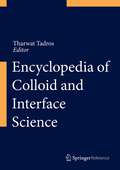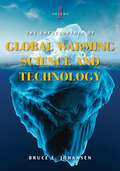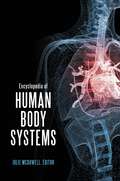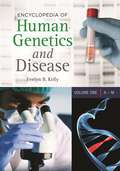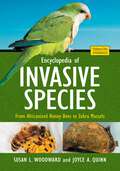- Table View
- List View
Encyclopedia of Chemical Processing and Design: Volume 65 -- Waste: Nuclear Reprocessing and Treatment Technologies to Wastewater Treatment: Multilateral Approach
by JohnJ. McKettaJr""Waste. Nuclear Reprocessing and Treatment Technologies to Waste, Solid, Trash Facts
Encyclopedia of Ecology and Environmental Management
by Peter P. CalowThe Encyclopedia of Ecology and Environmental Management addresses the core definitions and issues in pure and applied ecology. It is neither a short entry dictionary nor a long entry encyclopedia, but lies somewhere in between. The mixture of short entry definitions and long entry essays gives a comprehensive and up-to-date alphabetical guide to over 3000 topics, and allows any subject to be accessed to varying levels of detail; while the longer entries provide general reviews of subjects, the short definitions provide specific details on more specialised areas. An important feature of the Encyclopedia which sets it apart from other similar works is the comprehensive cross-referencing. The most comprehensive and up-to-date reference work in pure and applied ecology. Definitions cover the entire spectrum of pure and applied ecological research. Distinguished editorial board: Dr Peter Moore, Professor John Grace, Professor Bryan Shorrocks, Professor Steven Stearns, Professor Don Falk. International team of distinguished authors - over 200 contributors from 20 countries. 3000 headwords defined. Over 250 long entries review major topics. Heavily illustrated, with a section of colour plates. Complete one volume guide to pure and applied ecology. Presents cutting edge definitions in emerging fields as well as grounding in well-established areas of ecology.
Encyclopedia of Food Mycotoxins
by Martin WeidenbörnerAll relevant toxin producing fungi, their natural occurence, the possible mycotoxicosis, further the biochemical and physiological effects of mycotoxins, their chemical data and toxicity are treated here comprehensively. For each fungi, reference is given to the food at risk. All foods which have been reported to be contaminated with mycotoxins are listed, including data on the degree of contamination, the concentration of the toxins and the country of origin and/or detection of the contaminated food.
Encyclopedia of Geobiology (Encyclopedia Of Earth Sciences Ser.)
by Joachim Reitner and Volker ThielEncyclopedia of GIS
by Shashi Shekhar and Hui XiongThe Encyclopedia of GIS provides a comprehensive and authoritative guide, contributed by experts and peer-reviewed for accuracy, and alphabetically arranged for convenient access. The entries explain key software and processes used by geographers and computational scientists. Major overviews are provided for nearly 200 topics: Geoinformatics, Spatial Cognition, and Location-Based Services and more. Shorter entries define specific terms and concepts. The reference will be published as a print volume with abundant black and white art, and simultaneously as an XML online reference with hyperlinked citations, cross-references, four-color art, links to web-based maps, and other interactive features.
The Encyclopedia of Global Warming Science and Technology [2 volumes]: [2 volumes]
by Bruce E. JohansenIn this two-volume encyclopedia for general readers and students of all levels, Bruce E. Johansen marshals scientific work on global warming into 300 articles presented in clear and understandable language.Comprehensive in scope and accessible to all reader levels, The Encyclopedia of Global Warming Science and Technology covers a vast range of topics, concepts, issues, processes, and scientists sifted and melded from the many scientific and technological fields. These include atmospheric chemistry, paleoclimatology, biogeography, oceanography, geophysics, glaciology, soil science, and more.Bruce E. Johansen digests the explosion of scientific work on global warming that has been published since 1980 and presents it in a set that is sure to be the indispensable standard reference work on the topic. The information here is of importance to just about everyone on the planet—for the findings of global warming science and technology should dictate the choices we make today to secure our common future. This encyclopedia will prove useful for many different types of professionals, inasmuch as global warming science informs public policy debates, applied science, and technology in such fields as energy generation, architecture, engineering, and agriculture.
Encyclopedia of Human Body Systems [2 volumes]: [2 volumes]
by Julie McDowellThis encyclopedia is a concise yet comprehensive guide to the systems of the human body that is accessible to the lay reader.Ligaments and lymphatic fluid. The heart and the hormone regulatory system. The respiratory and reproductive systems. The human body comprises a myriad of fascinating, complex, and efficient systems, many of which operate constantly without our knowledge or awareness—that is, until we become ill or injured.This encyclopedia provides a concise yet comprehensive introduction to each of the systems of the human body, exploring all 11 organ systems of the human body: the circulatory, digestive, endocrine, integumentary, lymphatic, muscular, nervous, reproductive, respiratory, skeletal, and urinary systems. Each chapter includes detailed descriptions of important physiological processes, cell and tissue types, as well as the organs and their roles within the larger system. Special attention is also given to the ways in which these systems interact. Written in accessible prose, this text is an easy-to-understand reference for lay readers of any age and an ideal resource for any high school health curriculum.
The Encyclopedia of Human Ecology [2 volumes]: [2 volumes]
by Julia R. Miller Richard M. Lerner Lawrence B. Schiamberg Pamela M. AndersonThe first—and only—source to integrate the multiple disciplines and professions exploring the many ways people interact with the natural and designed environments in which we live.Comprising more than 250 informative entries, The Encyclopedia of Human Ecology examines the interdisciplinary and complex topic of human ecology. Knowledge gathered from disciplines that study individuals and groups is blended with information about the environment from the fields of family science, geography, anthropology, urban planning, and environmental science. At the same time, professions intended to enhance individual and family life—marriage and family therapy, clinical psychology, social work, dietetic and other health professions—are represented alongside those concerned with the preservation, conservation, and management of the environment and its resources.How rampant are eating disorders among our youth? Are AIDS educational programs effective? What problems do adolescents transitioning into adulthood encounter? Here, four leading scholars in the field have assembled a team of top-tier psychologists, sociologists, anthropologists, and other experts to explore these and hundreds of other timely issues.
Encyclopedia of Human Genetics and Disease [2 volumes]: [2 volumes]
by Evelyn B. KellyThis two-volume encyclopedia examines the history, characteristics, causes, and treatment of genetic disease, as well as the science of genetics itself.Modern science has unlocked many of the mysteries of genetics, providing a blueprint for understanding the origins behind previously mysterious ailments and conditions, both common and uncommon. A complete understanding remains elusive, however: geneticists are still refining theories about what causes chromosomes to mutate, and genetic diseases remain difficult to diagnose and challenging to treat. This fascinating reference explores the scientific and human aspects of this complex field of science.Encyclopedia of Human Genetics and Disease features nearly 400 entries, including well-known genetic diseases, rare and lesser-known genetic diseases, and the genetic factors that may contribute to common diseases and health conditions, such as breast cancer and obesity. The author presents in-depth discussions of concepts essential to understanding genetic disease in 18 entries that provide background on key topics, such as "Genetics 101," the genome and the foundations of genetics, genetic counseling, and newborn screening. Each of the 355 disorders profiled provides the history of the condition, its prevalence, causes, treatment (if any), and further reading. Interesting sidebars and compelling photos that help inform content accompany many entries.
Encyclopedia of Human Genetics and Disease [2 volumes]: [2 volumes]
by Evelyn B. KellyThis two-volume encyclopedia examines the history, characteristics, causes, and treatment of genetic disease, as well as the science of genetics itself.Modern science has unlocked many of the mysteries of genetics, providing a blueprint for understanding the origins behind previously mysterious ailments and conditions, both common and uncommon. A complete understanding remains elusive, however: geneticists are still refining theories about what causes chromosomes to mutate, and genetic diseases remain difficult to diagnose and challenging to treat. This fascinating reference explores the scientific and human aspects of this complex field of science.Encyclopedia of Human Genetics and Disease features nearly 400 entries, including well-known genetic diseases, rare and lesser-known genetic diseases, and the genetic factors that may contribute to common diseases and health conditions, such as breast cancer and obesity. The author presents in-depth discussions of concepts essential to understanding genetic disease in 18 entries that provide background on key topics, such as "Genetics 101," the genome and the foundations of genetics, genetic counseling, and newborn screening. Each of the 355 disorders profiled provides the history of the condition, its prevalence, causes, treatment (if any), and further reading. Interesting sidebars and compelling photos that help inform content accompany many entries.
Encyclopedia of Image Processing
by Phillip A. LaplanteThe Encyclopedia of Image Processing presents a vast collection of well-written articles covering image processing fundamentals (e.g. color theory, fuzzy sets, cryptography) and applications (e.g. geographic information systems, traffic analysis, forgery detection). Image processing advances have enabled many applications in healthcare, avionics, robotics, natural resource discovery, and defense, which makes this text a key asset for both academic and industrial libraries and applied scientists and engineers working in any field that utilizes image processing. Written by experts from both academia and industry, it is structured using the ACM Computing Classification System (CCS) first published in 1988, but most recently updated in 2012.
Encyclopedia of Infectious Diseases: Modern Methodologies
by Michel TibayrencDiscover how the application of novel multidisciplinary, integrative approaches and technologies are dramatically changing our understanding of the pathogenesis of infectious diseases and their treatments. Each article presents the state of the science, with a strong emphasis on new and emerging medical applications. The Encyclopedia of Infectious Diseases is organized into five parts. The first part examines current threats such as AIDS, malaria, SARS, and influenza. The second part addresses the evolution of pathogens and the relationship between human genetic diversity and the spread of infectious diseases. The next two parts highlight the most promising uses of molecular identification, vector control, satellite detection, surveillance, modeling, and high-throughput technologies. The final part explores specialized topics of current concern, including bioterrorism, world market and infectious diseases, and antibiotics for public health. Each article is written by one or more leading experts in the field of infectious diseases. These experts place all the latest findings from various disciplines in context, helping readers understand what is currently known, what the next generation of breakthroughs is likely to be, and where more research is needed. Several features facilitate research and deepen readers' understanding of infectious diseases: Illustrations help readers understand the pathogenesis and diagnosis of infectious diseases Lists of Web resources serve as a gateway to important research centers, government agencies, and other sources of information from around the world Information boxes highlight basic principles and specialized terminology International contributions offer perspectives on how infectious diseases are viewed by different cultures A special chapter discusses the representation of infectious diseases in art With its multidisciplinary approach, this encyclopedia helps point researchers in new promising directions and helps health professionals better understand the nature and treatment of infectious diseases.
Encyclopedia of Invasive Species [2 volumes]: From Africanized Honey Bees to Zebra Mussels [2 volumes]
by Susan L. Woodward Joyce A. QuinnThis two-volume set provides a one-stop resource on invasive plants, animals, fungi, and microorganisms that are threatening native ecosystems, agriculture, economies, and human health in the United States.Kudzu vine and field bindweed. Eurasian collared-doves, Burmese pythons, and black rats. The northern snakehead and the gypsy moth. All of these are examples of invasive species that have taken over or are threatening certain ecosystems—places where these organisms never naturally occurred. This two-volume work contains 168 entries on plants, animals, fungi, and microorganisms that are invasive in the United States, providing a complete examination of the variety of organisms, pathways, distribution patterns, and impacts of non-native species introduced to this country.Encyclopedia of Invasive Species: From Africanized Honey Bees to Zebra Mussels begins with a background essay that illuminates the complexities of dealing with invasive animals and plants. Each entry provides information on the origins and invasion history of the species in question as well as a general description of the biology and ecology of each organism. Impacts—actual and potential, as well as management strategies—are addressed. Every species is depicted via photographs as well as maps that show its place of origin and invaded regions in the United States. This unique work presents fascinating scientific information as well as valuable insights about how seemingly minor events can drastically alter our environment.
Encyclopedia of Iron, Steel, and Their Alloys (Metals and Alloys Encyclopedia Collection)
The first of many important works featured in CRC Press’ Metals and Alloys Encyclopedia Collection, the Encyclopedia of Iron, Steel, and Their Alloys covers all the fundamental, theoretical, and application-related aspects of the metallurgical science, engineering, and technology of iron, steel, and their alloys. This Five-Volume Set addresses topics such as extractive metallurgy, powder metallurgy and processing, physical metallurgy, production engineering, corrosion engineering, thermal processing, metalworking, welding, iron- and steelmaking, heat treating, rolling, casting, hot and cold forming, surface finishing and coating, crystallography, metallography, computational metallurgy, metal-matrix composites, intermetallics, nano- and micro-structured metals and alloys, nano- and micro-alloying effects, special steels, and mining. A valuable reference for materials scientists and engineers, chemists, manufacturers, miners, researchers, and students, this must-have encyclopedia: Provides extensive coverage of properties and recommended practices Includes a wealth of helpful charts, nomograms, and figures Contains cross referencing for quick and easy search Each entry is written by a subject-matter expert and reviewed by an international panel of renowned researchers from academia, government, and industry. Also Available OnlineThis Taylor & Francis encyclopedia is also available through online subscription, offering a variety of extra benefits for researchers, students, and librarians, including: Citation tracking and alerts Active reference linking Saved searches and marked lists HTML and PDF format options Contact Taylor and Francis for more information or to inquire about subscription options and print/online combination packages.US: (Tel) 1.888.318.2367; (E-mail) e-reference@taylorandfrancis.comInternational: (Tel) +44 (0) 20 7017 6062; (E-mail) online.sales@tandf.co.uk
Encyclopedia of Language and Education: Literacy (Encyclopedia of Language and Education #2)
by Viv Edwards P. CorsonThis is the second volume of the Encyclopedia of Language and Education (8 vols). It draws on some 25 state-of-the-art reviews of current concerns in the study of literacy prepared by an international group of leading writers and researchers. It emphasizes the impact of globalization on our understanding of literacy. The approach is multidisciplinary, drawing on insights from fields as diverse as anthropology and computer science, sociolinguistics and psychology.
Encyclopedia of Marine Biotechnology
by Se-Kwon KimA keystone reference that presents both up-to-date research and the far-reaching applications of marine biotechnology Featuring contributions from 100 international experts in the field, this five-volume encyclopedia provides comprehensive coverage of topics in marine biotechnology. It starts with the history of the field and delivers a complete overview of marine biotechnology. It then offers information on marine organisms, bioprocess techniques, marine natural products, biomaterials, bioenergy, and algal biotechnology. The encyclopedia also covers marine food and biotechnology applications in areas such as pharmaceuticals, cosmeceuticals, and nutraceuticals. Each topic in Encyclopedia of Marine Biotechnology is followed by 10-30 subtopics. The reference looks at algae cosmetics, drugs, and fertilizers; biodiversity; chitins and chitosans; aeroplysinin-1, toluquinol, astaxanthin, and fucoxanthin; and algal and fish genomics. It examines neuro-protective compounds from marine microorganisms; potential uses and medical management of neurotoxic phycotoxins; and the role of metagenomics in exploring marine microbiomes. Other sections fully explore marine microbiology, pharmaceutical development, seafood science, and the new biotechnology tools that are being used in the field today. One of the first encyclopedic books to cater to experts in marine biotechnology Brings together a diverse range of research on marine biotechnology to bridge the gap between scientific research and the industrial arena Offers clear explanations accompanied by color illustrations of the techniques and applications discussed Contains studies of the applications of marine biotechnology in the field of biomedical sciences Edited by an experienced author with contributions from internationally recognized experts from around the globe Encyclopedia of Marine Biotechnology is a must-have resource for researchers, scientists, and marine biologists in the industry, as well as for students at the postgraduate and graduate level. It will also benefit companies focusing on marine biotechnology, pharmaceutical and biotechnology, and bioenergy.
Encyclopedia of Marine Biotechnology
by Se-Kwon KimA keystone reference that presents both up-to-date research and the far-reaching applications of marine biotechnology Featuring contributions from 100 international experts in the field, this five-volume encyclopedia provides comprehensive coverage of topics in marine biotechnology. It starts with the history of the field and delivers a complete overview of marine biotechnology. It then offers information on marine organisms, bioprocess techniques, marine natural products, biomaterials, bioenergy, and algal biotechnology. The encyclopedia also covers marine food and biotechnology applications in areas such as pharmaceuticals, cosmeceuticals, and nutraceuticals. Each topic in Encyclopedia of Marine Biotechnology is followed by 10-30 subtopics. The reference looks at algae cosmetics, drugs, and fertilizers; biodiversity; chitins and chitosans; aeroplysinin-1, toluquinol, astaxanthin, and fucoxanthin; and algal and fish genomics. It examines neuro-protective compounds from marine microorganisms; potential uses and medical management of neurotoxic phycotoxins; and the role of metagenomics in exploring marine microbiomes. Other sections fully explore marine microbiology, pharmaceutical development, seafood science, and the new biotechnology tools that are being used in the field today. One of the first encyclopedic books to cater to experts in marine biotechnology Brings together a diverse range of research on marine biotechnology to bridge the gap between scientific research and the industrial arena Offers clear explanations accompanied by color illustrations of the techniques and applications discussed Contains studies of the applications of marine biotechnology in the field of biomedical sciences Edited by an experienced author with contributions from internationally recognized experts from around the globe Encyclopedia of Marine Biotechnology is a must-have resource for researchers, scientists, and marine biologists in the industry, as well as for students at the postgraduate and graduate level. It will also benefit companies focusing on marine biotechnology, pharmaceutical and biotechnology, and bioenergy.
Encyclopedia of Marine Sciences
by Hanneke J. G. Baretta-Bekker Egbert K. Duursma Bouwe R. KuipersThe multidisciplinary nature of marine sciences (Geology, Biology, Physics, Chemistry, and Oceanography) is reflected in this references 1,980 up-to-date, alphabetically listed keywords with illustrations. These keywords provide valuable time-saving assistance when studying marine scientific literature. The brief explanation of the concepts, terminology, and methods makes this book more valuable than a pure glossary or dictionary.


